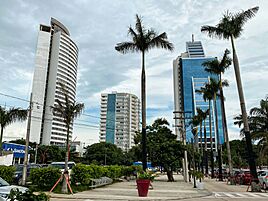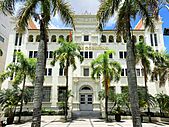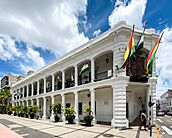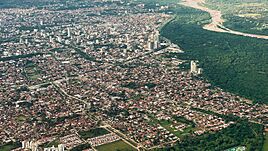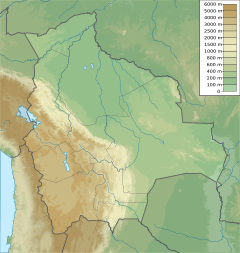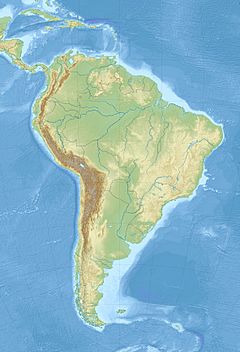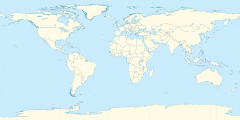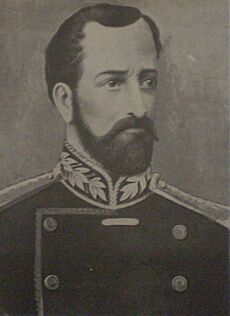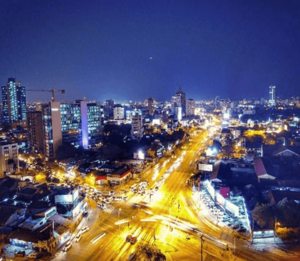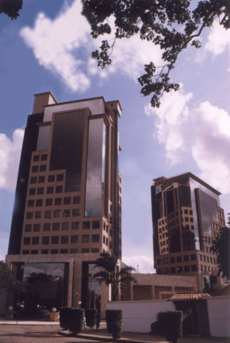Santa Cruz de la Sierra facts for kids
Quick facts for kids
Santa Cruz de la Sierra
|
|||
|---|---|---|---|
|
Autonomous city and municipality
|
|||
|
Equipetrol neighborhood
Cathedral Basilica of St. Lawrence
Casa del Pueblo
Municipal City Hall
Cristo Redentor
Aerial view of Santa Cruz de la Sierra and the Piray River
|
|||
|
|||
| Country | Bolivia | ||
| Department | Santa Cruz Department | ||
| Province | Andrés Ibáñez | ||
| Municipality | Santa Cruz de la Sierra | ||
| Founded | February 26, 1561 | ||
| Government | |||
| • Type | Municipal Autonomous Government | ||
| Area | |||
| • Total | 1,345 km2 (519 sq mi) | ||
| Elevation | 400 m (1,300 ft) | ||
| Population
(2024 Census)
|
|||
| • Total | 3,115,386 | ||
| • Density | 2,316.3/km2 (5,999.1/sq mi) | ||
| GDP (PPP, constant 2015 values) | |||
| • Year | 2023 | ||
| • Total | $23.3 billion | ||
| • Per capita | $12,800 | ||
| Time zone | UTC−4 (BOT) | ||
| Area code(s) | (+591) 3 | ||
| HDI (2016) | 0,827 Very High | ||
Santa Cruz de la Sierra is the biggest city in Bolivia. It is also the capital of the Santa Cruz department. People often just call it Santa Cruz. Its name means "Holy Cross of the Mountain Range" in Spanish.
The city is located by the Pirai River. This is in the eastern lowlands of Bolivia. The Santa Cruz de la Sierra area is the most populated part of Bolivia. About 2.4 million people lived there in 2020. It includes seven smaller towns like La Guardia and Warnes.
Spanish explorer Ñuflo de Chavez first started the city in 1561. It was about 200 kilometers (124 miles) east of where it is now. The city was moved a few times. It finally settled by the Pirai River in the late 1500s. For a long time, Santa Cruz was a small town. Even after Bolivia became independent in 1825, not many people moved there.
The city started to grow very fast in the mid-1900s. This happened after big changes to land ownership. Santa Cruz is in a low area near the Andes mountains. It is also part of the Amazon basin. This gives it a tropical climate. This is different from La Paz, which is much higher up.
Santa Cruz is Bolivia's largest city. It creates almost 35% of Bolivia's total money earned. It also gets over 40% of all foreign direct investment in the country. The city is Bolivia's most important business hub. Many people from Bolivia and other countries move here.
Contents
History of Santa Cruz
Early People of the Region
The history of the area before Europeans arrived is not well known. This is because the local tribes moved around a lot. They also did not have a written language. But new information shows that the area of Santa Cruz was home to an Arawak tribe. The Spanish later called them Chané.
Scientists have found old pottery and weapons here. This suggests the Chané had settled in the area. The first Spanish explorers met the Chané. They learned that the tribe had a leader called a cacique. One famous leader was Grigotá. His rule ended after attacks from the Guarani (Chiriguano) tribes.
How Santa Cruz Was Founded
The first Europeans came from Spain. They were conquistadores (Spanish conquerors). They came from a new area called the Governorate of New Andalusia. This area included parts of modern-day Argentina, Uruguay, Paraguay, and Chile.
In 1549, Captain General Domingo Martinez de Irala explored the region. But it was Ñuflo de Chavez who led a new trip in 1558. He wanted to start a settlement. Chavez went to Lima and convinced the Viceroy (a royal official) to create a new province. He became its governor on February 15, 1560.
Chavez founded the city of Santa Cruz de la Sierra on February 26, 1561. It was 220 kilometers (137 miles) east of its current spot. He named it after his hometown in Spain. The city was meant to be the capital of the new province of Moxos and Chaves.
Moving the City
Soon after it was founded, local tribes attacked the city often. Ñuflo de Chaves was killed in 1568. After his death, there were more conflicts. There were also power struggles within the settlement. So, leaders in Peru ordered the city to move west.
Many people chose to stay at the first location. On September 13, 1590, the city officially moved. It went to the banks of the Guapay Empero river. It was renamed San Lorenzo de la Frontera. But conditions were even harder there. So, the settlers had to move again on May 21, 1595.
This was the final move for the city. But the name San Lorenzo was still used until the early 1600s. Then, the people who stayed at the first Santa Cruz de la Sierra were convinced to move to San Lorenzo. After they moved, the city was finally united in 1622. It took its original name, Santa Cruz de la Sierra. You can still visit the remains of the first settlement. It is called Santa Cruz la Vieja ("Old Santa Cruz").
Santa Cruz in Colonial Times
Over the next 200 years, Spanish rule grew. Many tribes either joined the Spanish or were defeated. Santa Cruz became a key place for Jesuit missions. These missions converted thousands of native people. These groups later became part of the mixed population of modern Santa Cruz and other Bolivian regions.
The small town also helped the Spanish Empire stop Portuguese Bandeirantes (explorers and slave hunters). Many of these attacks were stopped by force. The leaders in Lima saw how important this was. They gave the province a lot of freedom.
Santa Cruz was ruled by a Captain General. The city government had two mayors and four council members. People in Santa Cruz did not have to pay imperial taxes. The mita system, which forced labor, was not used here. But the city did not grow much. Most money was made in mining areas to the west. Santa Cruz mainly relied on farming.
The Fight for Independence
People started to dislike the Spanish rulers in the early 1800s. This happened when a new system of intendencias (districts) came to the Americas. The main government office moved to Cochabamba. Many powers that the viceroyalty had given were now held by royal appointees.
Like in many parts of Spanish America, people were angry. They felt these changes threatened their way of life. They used the Peninsular War in Spain as a chance to act. On September 24, 1810, the local people revolted. They were led by Antonio Vicente Seonane. They removed the governor. A group of local commanders took control. At first, these revolutionaries were still loyal to the King of Spain.
By 1813, the city was back under Spanish control. Then, General Manuel Belgrano sent a small force from Argentina. It was led by Ignacio Warnes. Their goal was to "free" Santa Cruz. Warnes succeeded and took control of the city. In just over a year, Warnes gained huge support. He got locals, mixed-race people, and natives to join his army. He teamed up with another leader, Alvarez de Arenales. They defeated a strong Spanish force in the Battle of Florida. This was a big loss for the Spanish.
But two years later, Spanish forces attacked again. Francisco Javier Aguilera led this campaign. It ended with Ignacio Warnes and his forces being defeated and killed in the Battle of Pari. Aguilera marched into the city. He was ordered to stop the rebellion and bring back the Spanish governor. But this was hard. Many new revolutionary leaders rose up. They fought the Spanish rulers for seven years. They finally removed the last Spanish governor in February 1825. This happened after news of Spanish defeats in the west reached the city.
Geography of Santa Cruz
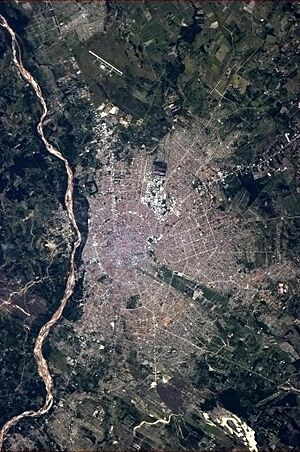
Santa Cruz is in the eastern part of Bolivia. Its coordinates are about 17°45' South and 63°14' West. It is about 400 meters (1,312 feet) above sea level. The city is part of the Andrés Ibáñez province. It is the capital of the Santa Cruz department. The Andes Mountains are not far from the city. You can see them from some parts of Santa Cruz.
Climate and Weather
Santa Cruz has a tropical savanna climate. This means it is generally warm all year. The average temperature is around 25°C (77°F). All months have temperatures above 18°C (64°F). The city is an example of how land affects temperature in the tropics. It does not have four clear seasons. But temperatures can change more than in coastal areas.
The weather is usually very warm. However, cold winds called "surazos" can blow in. These winds come from the Argentine pampas. They can make the temperature drop a lot, especially in winter. The months with the most rain are December and January. The city gets about 1321 mm (52 inches) of rain each year.
Santa Cruz is on the edge of the Codo de Arica. Winds are very strong here in Bolivia. Temperatures and rainfall can change a lot each year. This is common in this region. Annual rainfall has been between 900 and 2,300 mm (35 and 91 inches) recently.
| Climate data for Santa Cruz de la Sierra, elevation 416 m (1,365 ft), (1971–2009) | |||||||||||||
|---|---|---|---|---|---|---|---|---|---|---|---|---|---|
| Month | Jan | Feb | Mar | Apr | May | Jun | Jul | Aug | Sep | Oct | Nov | Dec | Year |
| Record high °C (°F) | 38.8 (101.8) |
39.5 (103.1) |
39.2 (102.6) |
36.7 (98.1) |
35.1 (95.2) |
34.0 (93.2) |
35.0 (95.0) |
37.3 (99.1) |
39.5 (103.1) |
39.0 (102.2) |
40.0 (104.0) |
39.1 (102.4) |
40.0 (104.0) |
| Mean daily maximum °C (°F) | 31.2 (88.2) |
30.9 (87.6) |
30.8 (87.4) |
29.4 (84.9) |
26.7 (80.1) |
25.2 (77.4) |
25.9 (78.6) |
28.2 (82.8) |
29.6 (85.3) |
31.1 (88.0) |
31.2 (88.2) |
30.8 (87.4) |
29.3 (84.7) |
| Daily mean °C (°F) | 26.3 (79.3) |
26.0 (78.8) |
25.9 (78.6) |
24.3 (75.7) |
21.9 (71.4) |
20.5 (68.9) |
20.4 (68.7) |
22.2 (72.0) |
23.7 (74.7) |
25.5 (77.9) |
25.9 (78.6) |
26.1 (79.0) |
24.1 (75.3) |
| Mean daily minimum °C (°F) | 21.4 (70.5) |
21.1 (70.0) |
21.0 (69.8) |
19.2 (66.6) |
17.1 (62.8) |
15.7 (60.3) |
14.9 (58.8) |
16.3 (61.3) |
17.8 (64.0) |
19.9 (67.8) |
20.6 (69.1) |
21.3 (70.3) |
18.9 (65.9) |
| Record low °C (°F) | 9.3 (48.7) |
12.0 (53.6) |
11.4 (52.5) |
8.5 (47.3) |
3.7 (38.7) |
4.0 (39.2) |
1.3 (34.3) |
1.9 (35.4) |
4.9 (40.8) |
7.0 (44.6) |
9.4 (48.9) |
13.3 (55.9) |
1.3 (34.3) |
| Average precipitation mm (inches) | 196.5 (7.74) |
160.3 (6.31) |
144.6 (5.69) |
115.4 (4.54) |
95.2 (3.75) |
74.2 (2.92) |
54.3 (2.14) |
55.9 (2.20) |
79.8 (3.14) |
119.0 (4.69) |
162.2 (6.39) |
195.9 (7.71) |
1,453.3 (57.22) |
| Average precipitation days | 14.4 | 13.6 | 13.6 | 10.7 | 10.6 | 9.0 | 5.8 | 5.1 | 6.2 | 8.4 | 10.3 | 13.8 | 121.5 |
| Average relative humidity (%) | 77.0 | 77.0 | 76.7 | 75.9 | 76.9 | 77.2 | 70.2 | 65.7 | 64.8 | 68.2 | 71.2 | 76.6 | 73.1 |
| Mean monthly sunshine hours | 181.3 | 185.0 | 165.4 | 195.3 | 180.5 | 155.9 | 162.2 | 162.8 | 181.8 | 164.4 | 140.3 | 136.8 | 2,011.7 |
| Source: Servicio Nacional de Meteorología e Hidrología de Bolivia | |||||||||||||
People of Santa Cruz
Santa Cruz is the largest city in Bolivia. It has a strong mix of mestizo (mixed European and Indigenous) and Creole (European descent born in the Americas) people. There is a smaller Indigenous population. The first people in Santa Cruz were mainly the native Chane people from eastern Bolivia. Then came the Spanish who arrived with Ñuflo de Chávez. Also, Guarani natives from Paraguay and other native groups lived there.
Over time, Spanish settlers and native people mixed. This is why most of the city's population is now mestizo. When the Spanish arrived, they brought Catholicism and the Spanish language. Now, most people in the city are Catholic and speak Spanish. However, some native religions and languages are still used by a smaller number of people.
For a long time, the people of Santa Cruz were different from those in western Bolivia. Western Bolivia had more Andean Indigenous people. But in the last 60 years, many people have moved from western Bolivia to Santa Cruz. This has changed the city's population. It has made the city more diverse. In recent years, people from other countries have also moved to Santa Cruz. Many immigrants come from Argentina, Brazil, Spain, Peru, United States, and Mexico.
Economy and Business
Santa Cruz de la Sierra has good services like roads and businesses. The main parts of its economy are oil, logging companies, agribusiness (farming and food production), and construction. Santa Cruz produces over 80% of Bolivia's farm goods. It has also contributed over 35% of Bolivia's total economic output in recent years.
Santa Cruz de la Sierra has Bolivia's largest airport. It is called Viru Viru International Airport. Many airlines fly there, including international ones. The airline AeroSur used to have its main office in Santa Cruz. It stopped flying in 2012. Now, Boliviana de Aviación flies from Santa Cruz to cities like Miami, Madrid, São Paulo, Buenos Aires, and Lima.
The city used to have a train line to Corumbá, Brazil. This line was known for not being very safe. It was closed after a highway to Brazil was built in the 1980s. Bolivia's largest shopping mall, the Ventura Mall, is also located in Santa Cruz.
Cities Santa Cruz is Connected To
Santa Cruz de la Sierra has many sister cities. These are cities that have special friendly relationships.
Famous People from Santa Cruz
- Udalrico Zambrana (born 1938) - a well-known poet.
See also
 In Spanish: Santa Cruz de la Sierra para niños
In Spanish: Santa Cruz de la Sierra para niños


